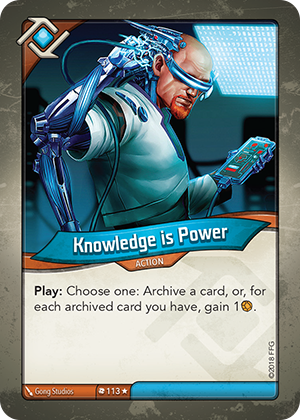A player’s archive is typically a facedown game area that is used for hand management. Why you may ask. From a design perspective, the archive serves two purposes. First, you can archive away less useful or conditional cards and make it more likely to get the cards you really need after shuffling back in your deck. Second, you can choose to return the archive to your hand allowing you to plan a monster turn where you store pieces of a combo in the archive until you drew the other pieces. It basically ensures a bigger and a specific hand on a future turn.
This mechanic is really well suited to mitigate some of the randomnesses in unique deck games (Keyforge).
Definition
Archiving in card games is a mechanic that allows placing cards on a temporary stack to access them again at a later time.
Use Cases
This mechanism is used to:
- have situational cards available for later use
- save combo pieces until you have found the other pieces
- collect resources for a particularly strong turn
- thinning your deck to increase chances to draw cards you are looking for
Games Using this mechanic:
- Keyforge
- Dominion
Podcast Episodes mentioning this mechanic:
Definitions of the Mechanic:
Keyforge: “A player’s archives is a facedown game area in front of that player’s identity card. Card abilities are the only means by which a player is
permitted to add cards to their archives. During step 2 of a player’s turn, after they select an active house, the active player is permitted to pick up
all cards in their archives and add those cards to their hand. Cards in a player’s archives are considered out of play. A player may look at their archives at any time. A player is not permitted to look at an opponent’s archives. If the ability instructing a player to archive a card does not specify where the card is archived from, the archived card comes from that player’s hand.”
Source: Keyforge Rulebook
ExamplaryCards:

Archiving in keyforge – knowledge is power

Archiving In Keyforge – Vezyma Thinkdrone

Archiving in Dominion
